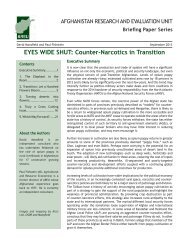Local Governance in Afghanistan: A View from the Ground
Local Governance in Afghanistan: A View from the Ground
Local Governance in Afghanistan: A View from the Ground
- No tags were found...
You also want an ePaper? Increase the reach of your titles
YUMPU automatically turns print PDFs into web optimized ePapers that Google loves.
<strong>Afghanistan</strong> Research and Evaluation Unit<br />
2011<br />
argument for greater decentralisation. The precise nature of any devolution of powers to prov<strong>in</strong>cial<br />
and district l<strong>in</strong>e departments will need to be sector-specific. While partnerships between prov<strong>in</strong>cial<br />
l<strong>in</strong>e departments and NGOs <strong>in</strong> <strong>the</strong> health sector have been largely successful, similar arrangements<br />
will not be appropriate <strong>in</strong> <strong>the</strong> politically and culturally sensitive area of education, for example.<br />
The lack of coord<strong>in</strong>ation between local adm<strong>in</strong>istrations, l<strong>in</strong>e m<strong>in</strong>istries and NGOs was found to be<br />
responsible for much <strong>in</strong>efficiency <strong>in</strong> service delivery. In some districts, governors compla<strong>in</strong>ed that<br />
many NGOs were work<strong>in</strong>g without <strong>in</strong>volv<strong>in</strong>g—or sometimes even <strong>in</strong>form<strong>in</strong>g—district adm<strong>in</strong>istrations.<br />
In some prov<strong>in</strong>ces, national NGOs with no credentials and dubious motivations had been registered<br />
and given permission to operate by <strong>the</strong> prov<strong>in</strong>cial MoEcon office, particularly <strong>in</strong> <strong>the</strong> rural development<br />
sector. These examples illustrate <strong>the</strong> need for much greater coord<strong>in</strong>ation among such bodies,<br />
particularly at district level, but also between prov<strong>in</strong>ce and district.<br />
The NSP fur<strong>the</strong>r adds to this lack of coord<strong>in</strong>ation s<strong>in</strong>ce it bypasses <strong>the</strong> prov<strong>in</strong>cial and district plann<strong>in</strong>g<br />
processes. Though common goods like roads, bridges and reta<strong>in</strong><strong>in</strong>g walls have been designed and<br />
delivered through <strong>the</strong> NSP, <strong>the</strong>y are planned <strong>in</strong> isolation. Coupled with a lack of technical expertise,<br />
prioritisation at <strong>the</strong> village level without reference to higher level plann<strong>in</strong>g strategies has resulted<br />
<strong>in</strong> a number of unsusta<strong>in</strong>able projects. Although <strong>the</strong> programme has achieved measured success <strong>in</strong><br />
deliver<strong>in</strong>g development goods, it rema<strong>in</strong>s heavily dependent on facilitat<strong>in</strong>g partners, with consequent<br />
doubts as to its susta<strong>in</strong>ability.<br />
As mentioned above, <strong>the</strong>re are significant problems associated with militarised aid delivery. There<br />
are circumstances where military support is <strong>the</strong> only option available, and <strong>in</strong> areas rendered<br />
<strong>in</strong>accessible by geography, disaster, <strong>in</strong>security or <strong>in</strong> <strong>the</strong> immediate aftermath of conflict, <strong>the</strong> military<br />
have performed a highly beneficial humanitarian role. However, its role <strong>in</strong> deliver<strong>in</strong>g longer-term<br />
development is questionable. There is a cultural gulf between <strong>the</strong> military and local populations<br />
and it is doubtful whe<strong>the</strong>r <strong>the</strong> strategy of us<strong>in</strong>g service delivery to w<strong>in</strong> hearts and m<strong>in</strong>ds actually<br />
works. Added to this is <strong>the</strong> fact that military development delivery cast <strong>the</strong> PRT <strong>in</strong> <strong>the</strong> role of patron.<br />
People thus turn to <strong>the</strong> PRT and not <strong>the</strong> government, despite <strong>the</strong> strenuous efforts of PRTs to use<br />
aid to support <strong>the</strong> government and work through government channels. 150 It is thus understandable<br />
that President Karzai wishes to see <strong>the</strong>m removed s<strong>in</strong>ce <strong>the</strong>y represent a very significant fund<strong>in</strong>g<br />
l<strong>in</strong>e outside of <strong>the</strong> government. Military <strong>in</strong>volvement <strong>in</strong> aid delivery should be reduced, and greater<br />
emphasis placed on tried and tested approaches that focus more on culturally appropriate ways to<br />
deliver development, alleviate poverty and reduce social <strong>in</strong>equality. 151<br />
Policy Issues: Prov<strong>in</strong>cial and district l<strong>in</strong>e departments should be allowed greater plann<strong>in</strong>g and<br />
budgetary powers for development programm<strong>in</strong>g, while representative bodies should have an<br />
<strong>in</strong>creased responsibility and associated powers <strong>in</strong> plann<strong>in</strong>g and monitor<strong>in</strong>g. The establishment of<br />
partnerships between m<strong>in</strong>istries and non-state actors <strong>in</strong> sectors o<strong>the</strong>r than health should also be<br />
explored. This will compensate for weak local government capacity and at <strong>the</strong> same time, help<br />
improve coord<strong>in</strong>ation between NGOs and prov<strong>in</strong>cial or district adm<strong>in</strong>istrations <strong>in</strong> <strong>the</strong>ir areas of<br />
responsibility. Capacity build<strong>in</strong>g should be an <strong>in</strong>tegral component of all such <strong>in</strong>itiatives to ensure<br />
that delivery mechanisms rema<strong>in</strong> effective and susta<strong>in</strong>able as and when NGO support reduces or is<br />
withdrawn. Where possible, service delivery should be carried out by civilians.<br />
7.11 Capacity build<strong>in</strong>g<br />
S<strong>in</strong>ce 2002, a series of adm<strong>in</strong>istrative reforms have been <strong>in</strong>troduced at <strong>the</strong> prov<strong>in</strong>cial and district levels.<br />
As has been noted <strong>in</strong> Section 3.1, this has <strong>in</strong>volved <strong>in</strong>itiat<strong>in</strong>g a system of merit-based appo<strong>in</strong>tment and<br />
revis<strong>in</strong>g <strong>the</strong> salaries of civil servants through <strong>the</strong> PRR process. The expectation was that <strong>the</strong>se measures<br />
would create an efficient and service-oriented public management system. However, reforms have not<br />
been accompanied by a clear strategy on expand<strong>in</strong>g civil servant capacity. Low capacity, among o<strong>the</strong>r<br />
factors, has also constra<strong>in</strong>ed prov<strong>in</strong>cial council members <strong>from</strong> fulfill<strong>in</strong>g <strong>the</strong>ir functions.<br />
150 Gen. David Petraeus, “COMISAF’s Counter<strong>in</strong>surgency (COIN) Contract<strong>in</strong>g Guidance” (Kabul: ISAF Headquarters, 2010).<br />
151 “Quick Impact, Quick Collapse” (2010).<br />
<strong>Local</strong> <strong>Governance</strong> <strong>in</strong> <strong>Afghanistan</strong>: A <strong>View</strong> <strong>from</strong> <strong>the</strong> <strong>Ground</strong><br />
66

















